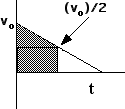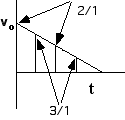Goal: Distinguish average velocity from velocity.
Source: UMPERG
A car is initially located at the 109 mile marker on a long straight
highway. Two and one half minutes later the car is located at the 111
mile marker.
What is the velocity of the car?
- 24 mph
- 32 mph
- 40 mph
- 48 mph
- 55 mph
- 64 mph
- Cannot be determined





Commentary:
Answer
The correct answer is (7) because only the average velocity can be
determined. However, students who respond (4) should not be
disconfirmed but prodded to be more discriminating when interpreting
questions. They have assumed that the car is traveling with a uniform
speed.
Background
Students should be able to extract kinematical quantities from everyday
situations. They should also have a sense of the size of these
quantities.
Questions to Reveal Student Reasoning
What is the speed of the car when it is at the 109 mile marker? How do
you know?
Is it possible for the car to be at rest initially and reach the 111
mile marker two and one half minutes later? If it had constant
acceleration, what would its speed be when it reached the 111 mile
marker?
Suggestions
Have students make a sketch of position vs. time. They probably assume
that the speed is uniform throughout the time interval. Have them
consider other paths that still connect the two known points on the
position vs. time plot. Draw some reasonable path and have the students
describe what the car is doing during that interval.